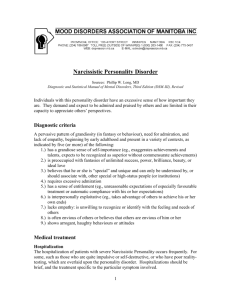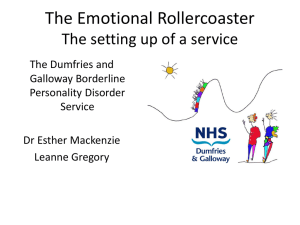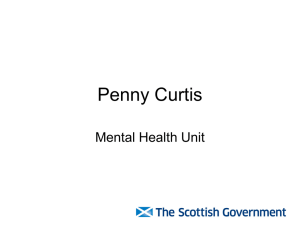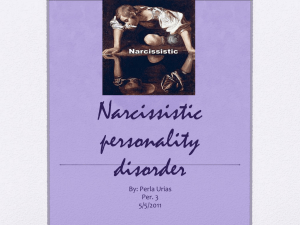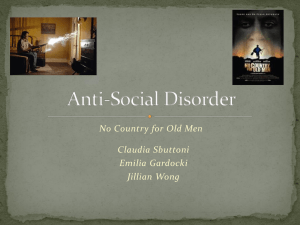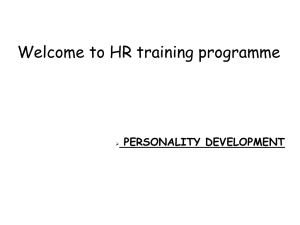Personality Disorders - HIV Training Track
advertisement
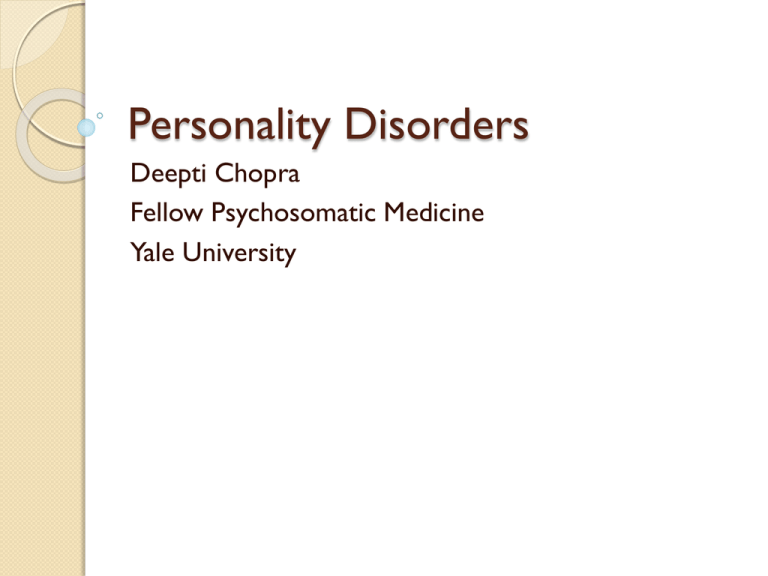
Personality Disorders Deepti Chopra Fellow Psychosomatic Medicine Yale University People at the Party (Dr.Suler) Winston spent most of the time talking about his trip to Europe, his new Mercedes and his favorite French restaurants. People seemed bored being around him, but he kept right on talking. When he made a critical remark about how one of the woman was dressed and hurt her feelings, he could not apologize for his obvious blunder. He tried to talk his way around it, and even seemed to be blaming her for being upset. Peter arrived at the party exactly on time. He made a point of speaking to every guest for five minutes. He talked mostly about technology and finance and avoided any inquiries about his personal life. He left precisely at 10pm because he had work to do at home. What is Different about them? Trait vs State Personality Trait An enduring pattern of perceiving, relating and thinking about the environment and oneself, that is seen in a wide range of social and personal situations Personality Disorder A) An enduring pattern of inner experience and behavior that deviates markedly from the expectations of individual's culture. This pattern is manifested in > 2/4 areas. i) Cognition, Affectivity, Interpersonal Functioning, Impulse Control. i) Cognition: manner of perceiving and interpreting self, others and events. ii) Affectivity: i.e. Range, intensity, lability, appropriateness of emotional response iii) Interpersonal functioning: i.e. Difficulty with maintaining boundaries. iv)Impulse control. Personality Disorder B) The enduring pattern is inflexible and pervasive across broad range or personal and social situations. C) The pattern leads to clinically significant distress or impairment in social, occupational or other important areas of functioning. D) The enduring pattern is stable and of long duration, and its onset can be traced back to at least to adolescence or early adulthood. E) The enduring pattern is not better accounted for as a manifestation or consequence of another mental disorder. F) The enduring pattern is not due to direct physiological effects of a substance (eg a drug of abuse , or medication) or a gmc (eg head trauma). Epidemiology Classification Hippocrates: Based on Body Humor ( ? Biological origin) Black Bile--- Sad, anxious- Melancholic Blood--- Warm hearted, optimistic Sanguine Yellow Bile – Quick tempered, angry Choleric Phlegm– Slow, lethargic, calm Phelgmatic Eysenck’s Theory: measures dimensions of personality Eysenck’s Dimensional Classification Classification per DSM IVTR Cluster A: "Eccentric" "Weird" "Odd" Paranoid personality disorder Schizoid personality disorder Schizotypal personality disorder Cluster B: "Erratic" "Wild" "Emotional" Borderline personality disorder Histrionic personality disorder Antisocial personality disorder Narcissistic personality disorder Cluster C: "Edgy" "Wimpy" "Anxious" Avoidant personality disorder Dependent personality disorder Obsessive Compulsive personality disorder Etiology: Biological Cluster A: FH of schizophrenia seen in Schizotypal pd. Cluster B: FH of depression in borderline pd. (mood disorder) ↑ testosterone in aggression. ↓ 5-HIAA in persons who attempt suicide, impulsive. Cluster C: Obsessive compulsive traits more common in mono zygotic twins. Etiology: Psychological Sigmund Freud: Fixation in psychosexual stage of development. Example: Oral stage- dependent pd. Anna Freud & Wilhelm Reich: Characteristic defensive style produce ego syntonic behavior. example: paranoid- project. Object relations theory: Self= subject, Other person=object, self representation, object representation. Melanie Klein: Paranoid schizoid position --> Depressive position. Heinz Kohut: External relations help maintain self esteem and self cohesion. Mirror transference and idealizing transference. Attachment theory: Ainsworth, Fonagy, Bowlby. Strange situation- secure: - insecure: avoidant, anxious ambivalent and disorganized types. The above conflicts /deficits will be enacted during therapy. Cluster B Case (DSM case bk) 19 yo M with punk hairstyle, was agitated, argumentative when brought into ER, by his friend. He had irregular breath, rapid pulse, dilated pupils. His mom arrived later, reportedthat he was disobedient, resentful to authority, unwilling to participate in family activities & violently argumentative when confronted about partying all night. He has h/o being arrested twice, for shoplifting and drunken driving. His parents divorced when he was 15, so he had no stable father figure, and it was difficult for his mother to discipline him. As per mother he was a fairly good student and a star member of the basket ball team. ( However, in reality pt never completed high school due to poor failing grades and never played basket ball.) Diagnosis of Antisocial Personality A) Pattern of disregard for and violation of rights of others occurring since age of 15, and indicated by >3/7 : "CORRUPT" Cannot follow norm or law. Obligations of work& finances ignored. Reckless disregard for self & others. Remorsefulness. Untruthfulness Planning deficits ( impulsivity, failure to plan ahead) Temper tantrums ( irritability, frequent fighting) Pt is at least 18 yrs. Etiology: Antisocial PD Biological: FH positive, then risk 5 times in 1st degree relatives ↓ in prefrontal gray matter ↓in callosal thickness (Raine et al 2005) ↓ 5- HIAA level. low Autonomic nervous system responsiveness. Psychological: Lacks super ego due to impairment in internalization . Defense mechanisms: externalization. Social: negative or conflicting parenting style in adolescent. Epidemiology Prevalence: *General population- 2-3%. *Males-3%, Females-1%, prisoners-75%. * ↑ ADHD , Substance use and Somatization d/o co-morbid. Course & Prognosis: common in poor urban area + high school drop outs. Impulsivity may improve with age, but continue to have trouble with working, parenting and romantic partners. Treatment Important to identify ASPD, BUT difficult to treat successfully. Medications: Psychotherapy: Difficult Impulsivity -Depakote/ Tegretol. Aggression-Beta blockers ◦ Outpatient individual therapy- not useful. * Should be initiated in structured settings- eg special units in prison, nonmedical community residential program etc. * Impulse--> Thought-->Action ◦ Inpatient: Disruptive for hospital settings. Cluster B Case Example 38 yo single AAF, living alone c/o depression secondary to social stressors. Her stress includes unemployment and caring for her ill sister and father. She has had 70jobs till now, but has been unable to find employment as she wants to work as a bus driver only and all other jobs are“useless”. She has h/o suicide attempt at age 16 , when she broke up with her boyfriend. Since then she is always attracted to married men, and was involved in 5 relationships till now. She avoids interacting with Afro American men as she does not trust them. Her sister was molested as a child, but pt denies any personal h/o abuse or trauma. On evaluation she is loud and irritable, talks incessantly about how everybody ill treats her. Diagnosis of Borderline pd A pervasive pattern of instability of interpersonal relationships, self image, and affects, marked by impulsivity indicated by >5/9 : “PRAISE” Paranoid ideation Relationship instability Affective instability Angry outbursts Abandonment Fears Impulsivity Identity disturbance Suicidal behavior Emptiness Etiology Borderline pd Biological: Heritability suggested, if mother with BPD, risk of bpd in child. Hyper-responsiveness 2’ry to early traumatic experience, ↑ ACTH& cortisol secretion noticed. Serotonergic involvement suspected. fMRI reveals enhanced amygdala activation, ↓hippocampal & amygdala volume in BPD Psychological: Lack of object constancy ( Kernberg) Rapproachment- constantly in infantile crisis. ( Mahler/ Kernberg) Inability to mentalize ( Fonagy) Etiology cont’d Defense mechanisms: splitting, primitive idealization/devaluation, projective identification. Social: Childhood trauma and abuse are important contributors. Chaotic home environment. Epidemiology of Borderline pd Prevalence ◦ General population: 0.7-1.8% ◦ Inpatient: 51% of all PD, Outpatient: 27% of all PD. ◦ Female: Male: 2:1 Diagnosed before age 40. Course & Prognosis: ◦ ◦ ◦ ◦ Fairly stable , no changes. Continue to have occupational and marital difficulties. ↑Eating disorder, substance use and PTSD. 10% commit suicide before 30 yo. Treatment Identify personality disorder , more early recognition ◦ First visit to finally finding a “good doctor” ◦ Chaotic lifestyle pattern Anticipate Future problems ◦ Demands : Set limits on the behavior. ◦ : Repetition is crucial. ◦ : Avoid confrontation ◦ Overdose: Minimal amount of medications with NO RF : Prefer meds with less addictive potential. • Open staff communication essential Treatment Medication and psychotherapy now standard Medication: ◦ One medication at a time. ◦ Symptomatic management, popular choice SSRI. Psychotherapy: ◦ Dialectical Behavioral Therapy ◦ Involves Mentalization, behavior and dialectics Cluster B Case (Gabbard) A male patient seeing a female therapist for the last time prior to her departure at the end of her residency. He tells her that he saw a movie the night before, in which the female psychiatrist kissed one of her male patients. Furthermore, the patient in the movie seemed to benefit from the therapist’s affection and asked his therapist, if she might do the same. After an initial anxious reaction to the request, the therapist asked him whether the unexpected request might be related to termination of the therapy. Diagnosis : Histrionic PD Diagnosis made is pattern of excessive emotionality and attention seeking is manifested in >5/8. “PRAISE ME” Provocative/ seductive behavior Relationships , considered more intimate that they are. Attention, must be center of Influenced easily. Speech impressionistic , lacking detail. Exaggerated emotions- theatrical. Make –up: physical appearance used to draw attention to self. Emotion lability, shallowness. Epidemiology Histrionic PD Prevalence General population: 2-3% Clinical population: 10-15% Female > Male: Associated with somatization and alcohol use. Course & Prognosis: Symptoms decline with age. Sensation seeker, thus likely to get in trouble with the law. Treatment Histrionic PD Unlike other pd’s , they will seek treatment. Medications: DepressionSSRI’s, Anxiety Anxiolytics Dissociation antipsychotics. Psychotherapy: help expression of repressed memories via language. *Mindful of erotic transference. *Acknowledge physical & affective display. *Help identify proper sense of self . Cluster B Case (Gabbard) Mr. F came to initial therapy after 3 previously failed attempts at therapy. Mr. F denigrated the previous therapeutic experience as “a complete waste of time” & could not even remember his therapist’s name (previous treatment lasted for 3 years). He further reported that “doctor what’s his name” interrupted him a lot and was not a good listener. Mr. F talked at length about his need for a “special” therapist & speculated that there might not be anyone who could really understand him. During session, he would ramble at length about his achievements & successful career. He would not allow therapist to intervene," Just let me finish this train of thought first.” Later, when the therapist tried to redirect him, he got upset and left. Diagnosis: Narcissistic PD Pervasive pattern of grandiosity (in fantasy or behavior), need for admiration, and lack of empathy, indicated by >5/9. ◦ “GRANDIOSE” Grandiose sense of self importance Requires excessive admiration Arrogant attitudes, behavior. Nasty preoccupation with fantasies of unlimited success, power and ideal love. Demands “special” treatment. Interpersonal exploitative. Often envious. Special, believes he is Empathy lacking Etiology Narcissistic PD Psychological: Kohut (Hypervigilant): requires special response from the environment, to maintain cohesive self. Considered as arrest in developmental stage. Kernberg (Oblivious): Self is a pathological structure, composed of fusion of ideal self, the ideal object & real self. Epidemiology: Narcissistic PD Prevalence: General population: <1 % Clinical settings: 1-16%. Course & Prognosis Chronic course Unable to handle aging. Vulnerable to midlife crisis depression. Treatment : Narcissistic PD Difficult to treat (You cannot fix awesome) Psychotherapy *Kohut: empathic validation. *Kernberg: interpretations and confrontation early. Pharmacotherapy Lithium for mood swings. SSRI for depression. Cluster C Case Example 45 yo M, lawyer sought treatment as his wife insisted. She was fed up with their marriage, she could no longer tolerate his emotional coldness, rigid demands, bullying behavior, sexual disinterest, long work hours & frequent business trips. Pt did not feel that his marriage was not working well. During the session, it was evident that he was troubled by many work problems, he was the youngest full partner, famous for handling many cases at the same time. But lately, he was finding it difficult to keep up. His coworkers were upset as he paid too much attention to minute details, & he did not delegate work responsibility to others. He was the son of two upwardly mobile, extremely hardworking parents. He grew up feeling, he never worked hard enough. He was a “bookworm”, a superior but awkward student in school. Diagnosis OCPD Pattern of orderliness, perfectionism, mental & interpersonal control, indicated in >4/8 . “Law Firms” Loses point of activity ( preoccupied with detail) Ability to complete tasks ( compromised by perfection) Worthless objects ( unable to discard) Friendships & leisure activities excluded (preoccupied with work) Inflexible, over conscientious ( ethics, values or morality) Reluctant to delegate Miserly Stubbornness. Etiology OCPD Biological: 1st born child. M>F. 1st degree relatives ( frequent) Psychological: Highly punitive superego->defenses like isolation of affect, intellectualization, reaction formation, undoing, displacement. Most recent: great deal of self doubt. D/D: OCD ( ego dystonic) Treatment OCPD Greatly improved with psychoanalysis or individual psychotherapy with an expressive emphasis. * help them explore their feelings * sometimes patient try to be the“perfect patient”. Pharmacotherapy Clomipramine Benzodiazipines Fluoxetine 60-80mg for OCD s/s. References Kaplan and Sadock’s: Synopsis of psychiatry. Hales RE, Yudofsky S: Textbook of Clinical Psychiatry.4th Ed. Gabbard G :Psychodynamic Psychiatry in Clinical Practice 4th Ed. Opi Akunnusi MD, lecture on Personality disorders for mnemonics Cases –Dr Suler J, dsm case book. Schwarcz G. Halaris A “Identifying and Managing Borderline Personality Patients” The American Family Physician. 1984 (29) 203-208.
